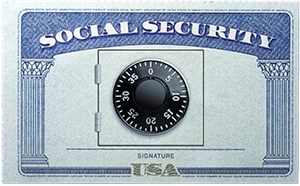Upcoming dates:
October 15
– Filing deadline for extended 2023 individual and C corporation tax returns
Achieving financial security for you and your family is no small task. With inflation and the allure of signing up for yet another monthly service, saving money can feel like an uphill battle. In this month’s newsletter, read about 5 ideas that can help you save money on your road to building wealth.
Also learn about several tips to protect your Social Security number, why you should think twice before tapping retirement accounts to pay for emergencies, and ideas that can help your kids thrive this school year.
Please pass this information on to anyone that may find it useful and call if you have any questions or concerns.
5 Ideas to Help Save Money

Creating a sound financial foundation for you and your family is anything but easy. It is tough to save when everyone is tempting you with adding one monthly service after another. Add to that the high increases in things like property taxes and insurance and you realize that saving is becoming more of an art form than a great habit. So here are some ideas to help build your wealth.
- Pay yourself first. Treat saving money with the same care as you pay your bills. Take a percentage of everything you earn and save it. Using this technique can help build an emergency fund and keep you from living paycheck to paycheck.
- Know and use the Rule of 72. You can roughly calculate the number of years compound interest will take to double your money using the Rule of 72. Do this by dividing 72 by your rate of return to estimate how long it takes to double your money. For example, 10% interest will double an investment in 7.2 years; investments with an 8% return will double in nine years. Use this concept to understand the power of saving and investment.
- Use savings versus debt for purchases. Unpaid debt is like compound interest but in reverse. For instance, using a 20% interest credit card to pay $1,500 for home appliances costs nearly $1,000 in interest expense if paid back over 5 years (on top of the original $1,500!). The result is that you have to work harder and earn more to pay for the items you purchase. A better idea is to save and then buy your dream item. Even better, when you save in a high interest account, you put interest to work for you to make the purchase more affordable.
- Understand amortization. When a bank loans you money, it gives you a specific interest rate and a set number of years to pay it back. Each payment you make contains interest as well as a reduction of the amount owed, called principal. Most of the interest payments are front-loaded, while the last few payments are virtually all principal. Making additional principal payments at the beginning of the loan’s term will decrease the amount of interest you pay to the bank and help you pay off the loan more quickly.
- Taxes are complex and require help. Tax laws are complicated. They are made even more complex when the rules change, often late in the year. Even worse, the IRS is not in the habit of telling you when you forget to take a deduction. The best way to stay out of the IRS spotlight AND to minimize your taxes is to ask for help.
Tips to Protect Your Social Security Number

Very few things in life can create a higher degree of stress than having your Social Security number (SSN) stolen. This is because, unlike other forms of identification, your SSN is virtually permanent. Here are some things that you can do to minimize the risk of having your number fall into the hands of the wrong people.
- Never carry your card. Place your SSN card in a safe place. That place is never your wallet or purse. Only take the card with you when you need it.
- Know who needs it. As identity theft continues to evolve, there are fewer people and organizations who really need to know your SSN. Here is that list:
- The government. Federal and state governments use this number to keep track of your earnings for retirement benefits and to ensure you pay proper taxes.
- Your employer. Your SSN is used to keep track of your wages and withholdings. It is also used to prove citizenship and to contribute to your Social Security and Medicare accounts.
- Certain financial institutions. Your SSN is used by various financial institutions to prove citizenship, open bank accounts, provide loans, establish other forms of credit, track digital payments, report your credit history, or confirm your identity. In no case should you be required to confirm more than the last four digits of your number.
- Challenge all other requests. Many other vendors may ask for your SSN, but having it may not be essential. The most common requests come from health care providers and insurance companies, but requests can also come from subscription services when setting up a new account. When asked on a form for your number, leave it blank. If your supplier really needs it, they will ask you for it. This allows you to challenge their request.
- Destroy and distort documents. Shred any documents that have your number listed. When providing copies of your tax return to anyone, distort or cover your SSN. Remember, your number is printed on the top of each page of Form 1040. If the government requests your SSN on a check payment, only place the last four digits on the check, and replace the first five digits with Xs.
- Keep your scammer alert on high. Never give out any part of the number over the phone or via email. Do not even confirm your SSN to someone who happens to read it back to you on the phone. If this happens to you, file a police report and report the theft to the IRS and Federal Trade Commission.
- Proactively check for use. Periodically check your credit reports for potential use of your SSN. If suspicious activity is found, have the credit agencies place a fraud alert on your account. Remember, everyone is entitled to a free credit report once a year. You can obtain yours on the Annual Credit Report website.
Replacing a stolen SSN is not only hard to do, it can create many problems. Your best defense is to stop the theft before it happens.
Think Before Tapping 401(k)s and IRAs as Emergency Fund

All Americans are now allowed to withdraw up to $1,000 every year from retirement accounts to pay for a broad range of emergency expenses. There are several reasons, however, why you should avoid tapping your retirement accounts at all costs.
Reasons to leave retirement funds alone
- You’re diluting your retirement savings. Although the money comes in handy now, you’re chipping away at your nest egg and forfeiting growth. For example, if you withdraw $100,000 that would earn 6% annually tax-deferred for ten years, you give up a whopping $79,000 in lost earnings!
- It may be bad timing. Experts say it’s difficult to time the markets in the current volatile environment. If you sell some holdings right now, you may be locking in losses that would miss future appreciation.
- You still owe income tax. Even if it’s for an emergency, income tax is due on all withdrawals from traditional 401(k)s and IRAs.
- You may also owe a penalty. You may have to pay a 10% penalty on your withdrawal if it doesn’t qualify for an IRS-defined exception.
Ideas to find cash
Instead of tapping into retirement funds, here are some ideas to generate the cash you need:
- Sell unwanted items. Take a look around your home for items that you no longer use such as clothes, electronics, or furniture, and sell them through an online marketplace.
- Rent out a room or other property. If you have extra space in your home, consider renting it out or finding a more long-term tenant. Be sure to check with your local government for rules on short-term rentals.
- Freelance or gig work. Many companies are looking for part-time workers and independent contractors instead of committing to a full-time employee. Consider reaching out to local businesses to offer your expertise, in addition to creating an online profile through platforms that are popular for consultants.
Straight As: Ideas to Help Your Kids Thrive This School Year

Your child’s education now features more screen time, more remote learning, and more opportunities to be tripped up in our online world. The good news is that you can still make a difference in your child’s life as they continue their journey from elementary school through high school. Here are some ideas to help your child thrive this school year.
- Design a workspace tailored to your child. Now that in-home learning is part of the normal routine, creating an environment tailored to your child’s learning style is key. While a separate room with dimmable lights and an air purifier might be ideal, a designated spot at the kitchen table with noise-cancelling headphones might just do the trick. The goal is to make a space that feels natural, with as little distractions as possible to encourage focused attention.
- Set them up for sleeping success. A good sleep routine is important for everyone, but it’s even more vital for kids’ cognitive development. According to the Mayo Clinic, kids ages 6 to 12 should be getting between 9 and 12 hours of sleep a night while teenagers need 8 to 10 hours. Count backwards from when they need to get up in the morning and add an hour to those ranges to allow for some downtime to help them transition their brains into sleep mode.
Downtime should consist of lighter, more relaxed activities like reading or reflecting on the day and avoiding using electronic devices if possible. Well-rested kids are better able to concentrate during the school day and handle the additional distractions that come with the hybrid approach.
- Teach them the good – and not so good – of AI. Plagiarism and artificial intelligence (AI) are major topics in schools. With AI now built into every search engine, creating what seems to be new content and ideas is easier and faster than ever. Because of this, schools have implemented AI-identifying software right into their grading systems to allow teachers to catch plagiarism as soon as assignments are submitted.
Talk to your kids about the importance of using AI simply as a research tool rather than a way to cut corners on an assignment. Like all new technology, there’s a learning curve associated with it and the quicker they can master the positive aspects of it while avoiding the negative, the better off they’ll be.
Every new school year is a new opportunity for new memories for both you and your children. By leaning into these and other ideas, you can help your kids thrive this school year.
